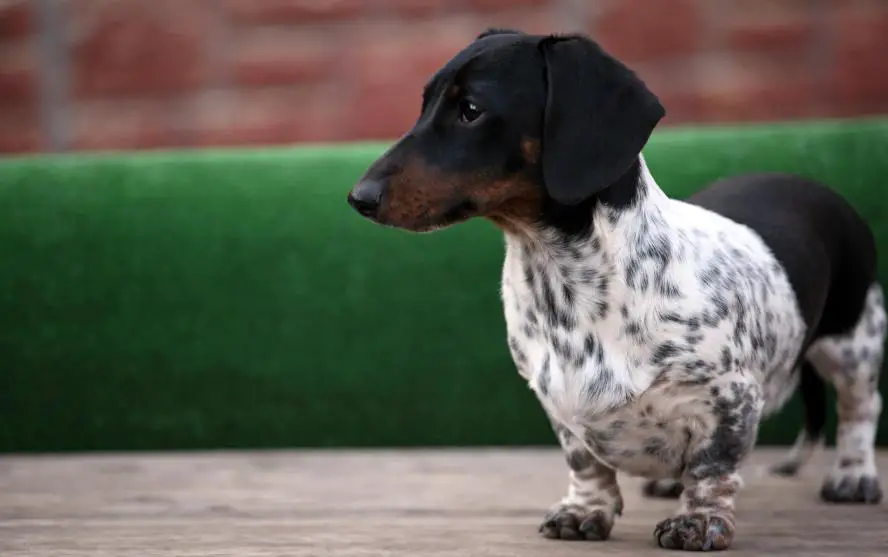Piebald is an eye-catching pattern (other than color) that is increasingly popular among Weiner dog lovers today.
Several Doxies possess the visually distinct piebald or pied coat pattern (combination of colors). The quickest way to identify a piebald Dachshund is by its white base coat covered by large asymmetrical dark-colored spots.
The spots range from small speckles to medium coin-sized spots or large patches. The amount and position of white can vary greatly from dog to dog but generally makes up more than 50% of the coat.
These spots can be any color or pattern including;
- Black
- Blue-gray
- Chocolate or brown
- Isabella
- Red or tan
- Black and tan
- Brindle
- Dapple
True piebalds have white tails and dark brown eyes. Most of the white will be on the legs, front chest, and underbelly but will vary from dog to dog. Some may have their entire backs covered by the secondary color but on some, it may be broken by the white color. The head may be completely colored (colored head) or marked with spots (ticked). A white neckband
With the extreme version of piebald, spotting is reduced with the entire skin and coat mostly unpigmented with exception of the eyes which remain colored. A Dachshund is considered extreme piebald if white makes up more than 80% of the coat.
Scroll on to learn what makes the piebald Dachshund.
Piebald Dachshund genetics
The piebald pattern is caused by a white spotting gene (Sp on the S-locus) which is said to be a codominant gene. Codominance (or incomplete dominance) means that the size of white patches varies from dog to dog depending on the number of S genes the dog carries.
A locus is a specific gene location on a chromosome (DNA chain). Each locus can have different versions of a specific gene known as alleles. Only two alleles have been proven to exist in the S-locus;
- S (solid color)– Has no white markings
- sp (piebald)– This is a mutant version of the MITF gene. Results in spots ranging from limited white spotting to an extensive white cover often colored head and patches on the body. A weiner dog that inherits one copy of this gene will have less white markings than one that inherits two copies.
The interaction between these two alleles is complex with varying effects on different dogs. These interactions remain mostly unknown with research and gene mapping still ongoing. For instance, having one copy of the piebald gene or Ssp may only cause white tips on the paws, tail, and chest but may also have more white patches or be solid-colored without white.
A dog that is spsp on the S-locus has more white roughly twice that on Ssp and is likely to have a solid-colored head. Some dogs may also have the extreme piebald pattern with white making up more than 80% of the coat that may also cover the head on the muzzle and blaze (stripe between the eyes). These are known as extreme piebald Dachshunds and are almost completely white. Typically, only the base of the tail is colored but other spots or patches can be anywhere on the body.
These genes impair the ability of particular areas to form color pigment causing them to appear white resulting in characteristic white patches. White spotting is the lack of either the black pigment (eumelanin) or red pigments (phaeomelanin). The lack of pigment largely affects some regions of the head, chest, underbelly, and some parts of the saddle. Color is mostly retained on the crucial areas such as internal organs where pigment is necessary for proper function.
Some piebalds will have ticking on the white coat that is believed to be controlled by a separate locus known as the T-locus (Ticking gene). Ticking are speckles of solid color on white areas
Extreme Piebald Dachshund
An extreme piebald Dachshund is one whose coat is almost entirely covered with white apart from small amounts of color on the head and the base of the tail. The dog is predominantly white which makes up more than 80% of the coat. Sometimes small colored patches may be present on the body too. Other times the nose may be partly pink and eventually turn black as the dog ages.
Most extreme piebald Dachshunds are speculated to be spsp on the S-locus. But it is possible there might be another reason for the extreme lack of pigmentation. One possible explanation would be the presence or an extreme spotting allele ( sw) which may be on a differnt locus. However, no evidence supports the presence of the extreme white spotting gene on Wiener dogs and so far all dogs with high amounts of white have been shown to have two piebald alleles.
Again, the spotting genes don’t seem to follow any specific rules with random results.
Extreme white occasionally causes problems when pigment is removed around the ears resulting in partial deafness or complete loss of hearing due to a lack of pigment in the inner ear structures. Only a few extreme piebald dogs are known to be deaf
(It is possible to have a chocolate and cream dapple brindle
piebald!!)

Piebald Vs Dapple Dachshund
Piebald and Double dapple Dachshunds look very similar and can be difficult to distinguish as they both tend to have extreme amounts of white patches on their bodies.
Dapple is a pattern caused by a variant of the dominant Merle gene (M). A dog with two copies of the dapple gene (MM) is said to be a double dapple and will have a mostly white coat. Dogs with a single copy of the dapple gene do not have large white since it is the second allele that blocks the synthesis of color pigment on the base color. The effects of double dapple will affect most of the pigmentation with increased cases of ear and eye complications.
One easy way to identify a Double Dapple Weiner dog is through the presence of pink speckles on most of their noses. Piebald will have no effect on most dog noses which remain largely colored.
Double Dapple Dachshunds are also likely to have one or two blue eyes. This is because the gene responsible for the dapple pattern may also result in loss of eye pigment. A piebald dog will have dark brown eyes.
A double dapple dog’s skin will also have pink patches as the genes affect deep in the skin. Piebald mostly affects the coat color and may not run deep into the skin.
The colored patches on a double dapple appear jagged and torn, unlike piebald patches that are more rounded on the edges.
What’s more, dapple only affects the black color pigment- eumelanin while piebald will affect both the black and red color pigments (phaeomelanin).

Piebald variations
As mentioned earlier piebald will affect a dog with any color or pattern. Below are some of the common piebald color combinations;
- Black and tan piebalds– have a white base color with black and tan patches or spots.
- Tuxedo Piebald– has a white background color with solid colored patches that are most often black. The white color often covered the chest, throat chin, the muzzle and blaze (a white strip between the eyes), tail-tip, and some or all the feet (white socks)
- Blue piebald– has a white base color with blue-gray patches. The Blue-gray patches are a result of dilution of the black color on the colored patches by the dilution gene. This dog is likely to have blue eyes.
- Chocolate piebald– has a white base color with chocolate or brown patches. The chocolate color is the result of the browning gene that turns black color pigment into a shade of brown.
- Isabella piebald– has a white base color with dusty/pale brown patches covering the coat and amber eyes. The pale brown on the colored patches is a result of the dilution of brown or chocolate color.
- Red piebald– has a white base color with red patches
- Dapple piebald– is a piebald dog with dapple patches. Dapple is a pattern on the colored patches
- Brindle piebald– has a white base color with bindle “tiger stripes” on the colored patches.
- Sable piebald– has a white base color with black and tan hairs on the colored patched. Each hair shaft on the patches is made up of two colors; red/tan base with black tips.
Piebald Dachshund price
The cost of a piebald Dachshund can range from as low as $800 to as high as $4000 depending on;
- Location.
- The dog coat type.
- Demand
- Pedigree.
Be cautious of anyone marketing their pied dogs as rare. Instead, do your homework to find the best and most reputable breeder.
FAQ
Can piebald Dachshunds be AKC registered?
Piebald Dachshunds can be AKC registered and can be shown for confirmation.
To qualify for shows, there should be no white shading on the colored parts of the coat. Ticking on the white areas of accepted but there should be no light-colored speckles on the skin including the nose, lips, and eye rims. The head should not be more than 50% white and the ears should be colored to avoid disqualification.
The nails may be wholly or entirely white
Can a piebald Dachshund have blue eyes?
Piebald Dachshunds should have brown eyes but not blue.
Health problems
Some extreme piebald Doxies may suffer from ear complications due to a lack of pigment in the inner ears which affects proper development and function. This occurs in Dachsunds with two copies of the piebald gene (spsp/extreme piebald) that have increased incidences of deafness.
However, the presence of extreme piebald is not sufficient to explain the cause of deafness as the majority of them will have normal hearing. As such it is important to eliminate other causes of partial or full deafness before concluding that it is due to the piebald gene.
Other than ear complications, there are no other known health problems stemming from the presence of the piebald gene.
To Sum up
The white often occurs at the edges of the tail tip, the muzzle, the paws, and the breastbone. With increased white spotting, white can occur on the front of the chest, more of the tail, the underbelly, and cover the collar. Only the head and base of the tail are likely to remain colored.
However, you should not base your buying decision on color alone as the piebald Dachshund is similar in characteristics to any Weiner dog with exception of the coat color.
Is a Pied Weiner dog a pooch you would fancy? Share your thoughts in the comment section below.
There you go, WOOF!

